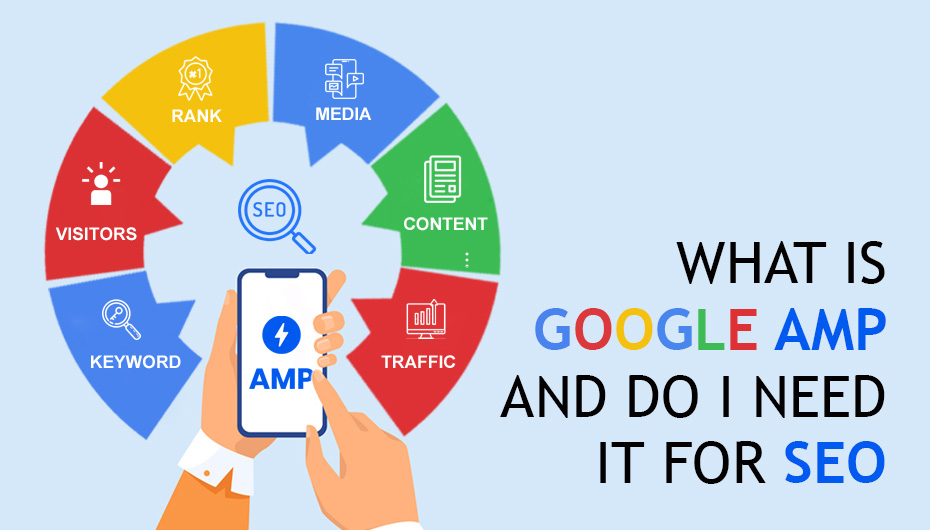Any Writer's, blogger's, basically any content creator's biggest dream is always that their creation reaches…
What Is Google AMP And Do I Need It For SEO?

According to a study, mobile traffic has increased vigorously in daily media consumption since 2011. Many consumers use mobile phones to access content; it is now more important to optimize for the mobile experience—not just for the readers, but also for the SEO; Google is able to detect pages that load very slow or have a high bounce rate and will rank the pages lower in our search results.
Everyone knows that mobile optimization is essential for SEO and your content strategy, and Google AMP is a technology devised to help with that; whether Google AMP is the perfect tool to do that for the business website depends on the content strategy, industry, business model, business size, and more.
Despite whether Google AMP is right for you, you will come away from the post with the SEO knowledge you need to feel confident about the site’s SEO and the mobile performance. AMP means Accelerated Mobile Pages. The AMP Project is an open-source initiative that is supported by Google. Those are thousands of websites, developers, tech firms, and publishers collaborating on the project. According to the project, it aims to make the web better for everyone.
And for that, it enables the creation of ads and websites that are consistently high-performing, fast and beautiful across devices. These ads and sites will meet the criteria by utilizing Google AMP Pages. AMP Pages load almost-instantly. This creates the more engaging, smooth mobile experience which both Google and the project are hoping for.
Three Core Components
AMP HTML
AMP HTML is with some restrictions for increased reliable performance. This is HTML with custom AMP features included. Many tags are usually HTML, with a few being replaced by AMP-specific ones. The AMP-specific tags create common patterns simpler to implement.
AMP JS Library
The next core component is the AMP JS Library. This ensures the fast rendering of AMP HTML pages. Their library implements AMP’s perfect performance practices. That is what provides the custom tags that modify AMP HTML from standard HTML.
One of the AMP JS Library’s key optimizations links to site elements coming from external resources. The elements are asynchronous for AMP Pages. This implies that they operate separately. Nothing from outer resources can block the page from rendering.
Google AMP Cache
Google AMP Cache is a proxy-based delivery network to deliver all valid AMP records. It can fetch AMP HTML pages, then catches them, and increases page performance automatically.
When using the Google AMP Cache, all images and all JS files load from the origin. The origin uses HTTP 2.0 for highest efficiency and load speed. The cache comes with a built-in validation system. This confirms that a page is confirmed to work and does not depend on outer resources.
Is AMP essential?
Before we talk about the pros and cons of Google AMP, it is necessary to note that as AMP will help the SEO, it is not significantly crucial for SEO in a few cases, and the advantages are more applicable to some of the businesses.
- AMP is broadly adopted by publisher sites having a high volume of blog posts or news articles or. If most of the website pages are not articles, then AMP is not necessary for the business.
- Suppose you do publish a huge volume of articles but are using a content delivery network. In this case, the platforms usually come with performance optimization features like lazy loading, image hosting, and file caching.
- AMP pages are simpler and cleaner for readers, but mostly because certain JavaScript plugins and functions are suppressed or deprioritized. If you rely on third-party tools for audience tracking and lead capturing, you will need to test to ensure your AMP pages capture information and function the same as the regular pages.
- AMP is not itself a Google ranking factor. It will help in improving aspects of the web pages that are factored into Google’s algorithm.
- Suppose you have a mobile version of the site or mobile optimization measures with you (like minified or consolidated CSS code). In this case, AMP might not be necessary and even complicate reporting and performance.
So the point here is, optimizing for mobile experience and page speed is crucial for SEO, and Google AMP is one way of accomplishing that. Read on to learn about how it is and if that is the right solution for you.
What are the benefits of Google AMP?
Apart from quicker loading speeds and a better exposure for content consumers, AMP gives several benefits to businesses with a SEO strategy and content.
Enhanced website engagement
The lightweight AMP content fits great with mobile users having a not-so-stable internet connection. Additionally, the drop in page load time improves the user experience to increase the possibilities of visitors staying on the site longer.
Improved ranking and traffic
Also, as the page load time is a Google ranking factor, AMPs have been prioritized in Google’s search algorithms, therefore affecting rankings. Importantly, if two sites stand the same, the faster one will win.
Lower bounce rates
With the pages loading faster, visitors normally stay onsite. A Google study have found that 53% of website visits are left if a mobile site is taking longer than 23 seconds to get loaded. Furthermore, publishers who implement AMP potentially get a double increase in time spent on that page. More time on the website will suggest more conversions from the content.
Increased ad views
Using AMP, the HTML is coded to enhance the overall usability of images and banners. It results in a high ad viewability rate, helping the publishers to improve opportunities for monetizing the content.
Higher click-through rates
A significant benefit of AMP is that it is showcased in a carousel of the Google mobile SERP, it appears on top of every search result. As a result, readers are highly likely to select the AMP pages first, which leads to enhanced click-through rates.
Current AMP statistics
As many popular websites have been using AMP technology today, like eBay, Yahoo, WordPress, CNN, Washington, BBC, Reddit, Post, Gizmodo, Wired, Pinterest, Independent.co.uk, and many more, not a technology reserved just for big brands. Over 1.4 million websites have been using AMP technology. Below are the industries that use AMP the most:
- Gaming accounts for about 5.15% of AMP technology usage.
- Science & Education is close behind at 5.88%.
- Computer Electronics & Technology accounts for almost 6%.
- Arts & Entertainment accounts for nearly 11% of total AMP technology usage.
- The remaining 73% is the total of every other industry’s insignificant percentages.
Conclusion
At a very simple level, Google AMP Pages are peeled down HTML copies of all the existing pages. These are versions of the pages optimized to load as fast as possible on mobiles. They are also not new. They have been around for a few years now. One of the causes, why some SEO pros are skeptical is how they first came about. Overall, this is essential for the growth of your page everywhere.




This Post Has 0 Comments